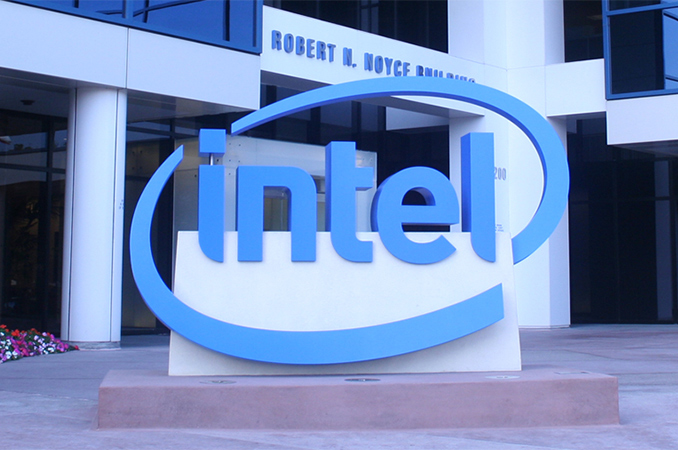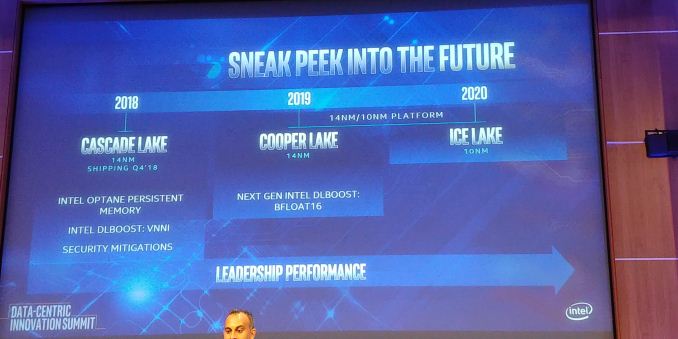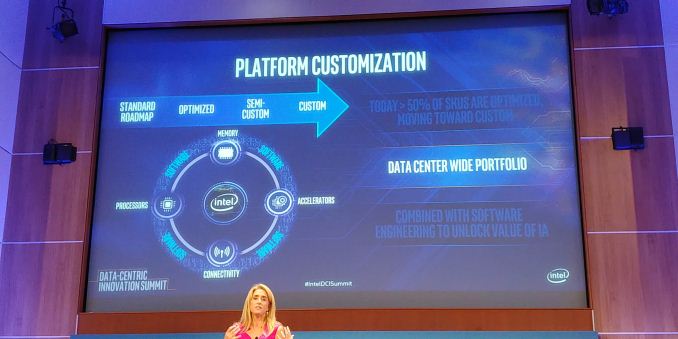Intel Server Roadmap: 14nm Cooper Lake in 2019, 10nm Ice Lake in 2020
by Ian Cutress & Anton Shilov on August 8, 2018 12:57 PM EST- Posted in
- Servers
- Xeon
- Ice Lake
- Cascade Lake
- Cooper Lake

At its Data-Centric Innovation Summit in Santa Clara today, Intel unveiled its official Xeon roadmap for 2018 – 2019. As expected, the company confirmed its upcoming Cascade Lake, Cooper Lake-SP and Ice Lake-SP platforms.
Later this year Intel will release its Cascade Lake server platform, which will feature CPUs that bring support for hardware security mitigations against side-channel attacks through partitioning. In addition, the new Cascade Lake chips will also support AVX512_VNNI instructions for deep learning (originally expected to be a part of the Ice Lake-SP chips, but inserted into an existing design a generation earlier).
Moving on to the next gen. Intel's Cooper Lake-SP will be launched in 2019, several quarters ahead of what was reported several weeks ago. Cooper Lake processors will still be made using a 14 nm process technology, but will support some functional improvements, including the BFLOAT16 feature. By contrast, the Ice Lake-SP platform is due in 2020, just as expected.
One thing to note about Intel’s Xeon launch schedules is that the Cascade Lake will ship in Q4 2018, several months from now. Normally, Intel does not want to create internal competition and release new server platforms too often. That said, it sounds like we should expect Cooper Lake-SP to launch in late 2019 and Ice Lake-SP to hit the market in late 2020. To make it clear: Intel has not officially announced launch timeframes for its CPL and ICL Xeon products and the aforementioned periods should be considered as educated guesses.
| Intel's Server Platform Cadence | ||||
| Platform | Process Node | Release Year | ||
| Haswell-E | 22nm | 2014 | ||
| Broadwell-E | 14nm | 2016 | ||
| Skylake-SP | 14nm+ | 2017 | ||
| Cascade Lake-SP | 14nm++? | 2018 | ||
| Cooper Lake-SP | 14nm++? | 2019 | ||
| Ice Lake-SP | 10nm+ | 2020 | ||
While the Cascade Lake will largely rely on the Skylake-SP hardware platform introduced last year (albeit with some significant improvements when it comes to memory support), the Cooper Lake and Ice Lake will use a brand-new hardware platform. As discovered a while back, that Cooper Lake/Ice Lake server platform will use LGA4189 CPU socket and will support an eight-channel per-socket memory sub-system.
Intel has long understood that one size does not fit all, and that many of its customers need customized/optimized Xeon chips to run their unique applications and algorithms. Google was the first company to get a semi-custom Xeon back in 2008, and today over a half of Intel Xeon processors are customized for particular workloads at particular customers. That said, many of Intel’s future Xeons will feature unique capabilities only available to select clients. In fact, the latter want to keep their IP confidential, so these chips will be kept off Intel’s public roadmap. Meanwhile, as far as Intel’s CPUs and platforms are concerned, both should be ready for various ways of customization whether it is silicon IP, binning for extra speed, or adding discrete special-purpose accelerators.
Overall there are several key elements to the announcement.
Timeline and Competition
What is not clear is timeline. Intel has historically been on a 12-18 month cadence when it comes to new server processor families. As it stands, we expect Cascade Lake to hit in Q4 2018. If Cooper Lake is indeed in 2019, then even if we went on the lower bound of at 12-18 month gap then we would still be looking at Q4 2019. Step forward to Ice Lake, which Intel has listed as 2020. Again, this sounds like another 12 month jump, on the edge of that 12-18 month typical gap. This tells us two things:
Firstly, Intel is pushing the server market to update and update quickly. Typical server markets have a slow update cycle, so Intel is expected to push its new products hoping to offer something special above the previous generation. Aside from the options listed below, and depending on how the product stack looks like, there is nothing listed about the silicon which should drive that updates.
Secondly, if Intel wants to keep revenues high, it would have to increase prices for those that can take advantage of the new features. Some media have reported that the price of the new parts will be increased to compensate the fewer reasons to upgrade to keep overall revenue high.
Security Mitigations
This is going to be a big question mark. With the advent of Spectre and Meltdown, and other side channel attacks, Intel and Microsoft have scrambled to fix the issues mostly through software. The downside of these software fixes is that sometimes they cause performance slowdowns – in our recent Xeon W using Skylake-SP cores, we saw up to a 3-10% performance decreases. At some point we are expecting the processors to implement hardware fixes, and one of the questions will be on the effect on performance that these fixes give.
The fact that the slide mentions security mitigations is confusing – are they hardware or software? (Confirmed hardware) What is the performance impact? (None to next-to-none) Will this require new chipsets to enable? Will this harden against future side channel attacks? (Hopefully) What additional switches are in the firmware for these?
Updated these questions with answers from our interview with Lisa Spelman. Our interview with Lisa will be posted next week (probably).
New Instructions
Running in line with new instructions will be VNNI for Cascade Lake and bfloat16 for Cooper Lake. It is likely that Ice Lake will have new instructions too, but those are not mentioned at this time.
VNNI, or Variable Length Neural Network Instructions, is essentially the ability to support 8-bit INT using the AVX-512 units. This will be one step towards assisting machine learning, which Intel cited as improving performance (along with software enhancements) of 11x compared to when Skylake-SP was first launched. VNNI4, a variant of VNNI, was seen in Knights Mill, and VNNI was meant to be in Ice Lake, but it would appear that Intel is moving this into Cascade Lake. It does make me wonder exactly what is needed to enable VNNI on Cascade compared to what wasn’t possible before, or whether this was just part of Intel’s expected product segmentation.
Also on the cards is the support for bfloat16 in Cooper Lake. bfloat16 is a data format, used most recently by Google, like a 16-bit float but in a different way. The letter ‘b’ in this case stands for brain, with the data format expected for deep learning. How it differs regarding a standard 16-bit float is in how the number is defined.
A standard float has the bits split into the sign, the exponent, and the fraction. This is given as:
- <sign> * 1 + <fraction> * 2<exponent>
For a standard IEEE754 compliant number, the standard for computing, there is one bit for the sign, five bits for the exponent, and 10 bits for the fraction. The idea is that this gives a good mix of precision for fractional numbers but also offer numbers large enough to work with.
What bfloat16 does is use one bit for the sign, eight bits for the exponent, and 7 bits for the fraction. This data type is meant to give 32-bit style ranges, but with reduced accuracy in the fraction. As machine learning is resilient to this type of precision, where machine learning would have used a 32-bit float, they can now use a 16-bit bfloat16.
These can be represented as:
| Data Type Representations | ||||||
| Type | Bits | Exponent | Fraction | Precision | Range | Speed |
| float32 | 32 | 8 | 23 | High | High | Slow |
| float16 | 16 | 5 | 10 | Low | Low | 2x Fast |
| bfloat16 | 16 | 8 | 7 | Lower | High | 2x Fast |
This is a breaking news that will be updated as we receive more information.
Related Reading:
- Intel 10nm Production Update: Systems on Shelves For Holiday 2019
- Intel’s Xeon Scalable Roadmap Leaks: Cooper Lake-SP, Ice Lake-SP Due in 2020
- Power Stamp Alliance Exposes Ice Lake Xeon Details: LGA4189 and 8-Channel Memory
- Intel’s High-End Cascade Lake CPUs to Support 3.84 TB of Memory Per Socket
- Intel Documents Point to AVX-512 Support for Cannon Lake Consumer CPUs
- Intel Begins EOL Plan for Xeon Phi 7200-Series ‘Knights Landing’ Host Processors
- Intel Shows Xeon Scalable Gold 6138P with Integrated FPGA, Shipping to Vendors
- Sizing Up Servers: Intel's Skylake-SP Xeon versus AMD's EPYC 7000 - The Server CPU Battle of the Decade?














51 Comments
View All Comments
WithoutWeakness - Wednesday, August 8, 2018 - link
It took until 2018 to see 10nm in any actual shipping processors from Intel (original date was expected in 2016). Actual mainstream release of 10nm consumer chips has been delayed until "holiday 2019" and 10nm server chips are still on the roadmap for 2020 at the earliest.Intel is giving AMD every opportunity to catch up and I'm glad to see that AMD is taking advantage of it. These sort of delays are allowing AMD to claw back market share and the closer the scale gets to equilibrium the better the competition will be. It is a good time to be a consumer.
Galid - Wednesday, August 8, 2018 - link
I don't know why you would ahve to say that it is a good time to be a consumer, for the prices to go down? From my core 2 duo e5200 that could overclock like crazy for pennies to my current i5 2500k that could overclock like crazy for pennies while AMD wasn't in the competition AT ALL I didn't feel like it was a bad time to be a consumer. Just look at the horizon now, every product that goes out, doesn't cut prices down like almost at all. Unless we're speaking about older ''non competing'' AMD processors pre Ryzen, pretty much every cpu from i5 2500k to i7 7700k hasn'T been going down in price much even tho ryzen brought some competition to them.From now on, companies like intell, Nvidia and AMD communicate between each other to avoid things like radeon 4870 super performance for the price to kill GTX 260 overpriced same performance to happen again. Just look with your own eyes what happened since then. Everything prices pretty much where it will stay for a while. Every product seems to land where it's supposed to be never undercutting prices from current products more than let's say 50$ if so.
wrkingclass_hero - Thursday, August 9, 2018 - link
The communication you are talking about is called collusion and it is illegal. Also, I doubt that Nvidia and AMD are colluding, Nvidia seems to be doing everything in their power to crush AMD, even shady stuff like putting pressure on third parties to align their brands exclusively to them, and limiting Nvidia GPU performance when used with Ryzen CPUs.Fritzkier - Thursday, August 9, 2018 - link
"From my core 2 duo e5200 that could overclock like crazy for pennies to my current i5 2500k that could overclock like crazy for pennies while AMD wasn't in the competition AT ALL I didn't feel like it was a bad time to be a consumer."IT IS a bad time to be a consumer. You said it yourself
"pretty much every cpu from i5 2500k to i7 7700k hasn'T been going down in price"
THAT'S the effect of no competition. After Ryzen, even Coffee Lake i3 almost comparable to Kaby Lake i5.
jospoortvliet - Thursday, August 9, 2018 - link
Yup. Prices have gone down finally- an intel quad-core at 4 ghz is cheaper today by a huge margin compared to 2 years ago... the gap is even bigger for 6 and 8 cores.Spunjji - Thursday, August 9, 2018 - link
I don't recall an i5 ever being worth "pennies" either. You could overclock the Core 2 e5200, not so with anything other than a K-series Intel CPU since then.His entire comment contradicts itself. Oh, the fine art of unpaid shilling. ^_^
mapesdhs - Thursday, August 9, 2018 - link
Plenty of people oc'd the i7 3820, not a K part. Ditto some of the XEONs for X79.close - Saturday, August 11, 2018 - link
@Galid, up to 2006-2007 AMD was still more or less in the play. And the CPUs that were launched shortly after (2008-2010) were still designed by Intel with AMD's pressure in mind. The price also reflected that pressure.The CPUs you are talking about were launched ~10, and 7+ years ago respectively. The 2500K at over $200 so not really pennies. I can draw you a picture of how prices have steadily gone up and performance improvements YoY decreased as Intel was further and further away from those times AMD put pressure on them. You'd still miss the point. And the line...
But it's "great" that companies can communicate to avoid "fiascos" like when one of them launches a great product with great performance and price. We definitely don't want that. Nope. Tragedy averted, customers rejoice.
@mapesdhs there's OC and OC. First off, you need the much more expensive LGA2011 platform to do any BCLK OC. "Regular" LGA1155 got about... 3% OC headroom. Impressive. Second, even so they still never reached the OC levels of the K parts. And third, a very small fraction of Intel's SKUs actually managed this at all so the 3820 really doesn't prove any point.
@everyone else, Galid isn't shilling, it's just painful lack of education.
RU482 - Saturday, August 11, 2018 - link
"pretty much every cpu from i5 2500k to i7 7700k hasn'T been going down in price"lol, you could look back 18 yrs to the Pentium 550e (the hotshot I5 equivalent back in early 2000) ran around the same price new as either of those processors.
nickolas84 - Wednesday, August 8, 2018 - link
Back in the day Intel was on 14nm and Apple was on 20nm. Right now Apple is plannining the release of 7nm chips and Intel is still on 14nm.I do not care how you meassure and if Intels 14nm are smaller than Apple's. The fact on the matter is that in the recent years Apple has shrunk its processes 8x and Intel just stood still. That is amazing in all the wrong ways for Intel, and kudos to Apple for actually moving things forward.